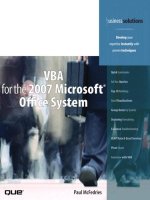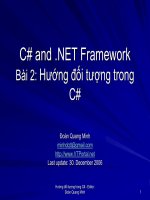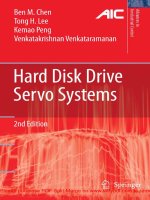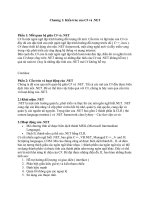Tài liệu C for The Microprocessor Engineer P1 docx
Bạn đang xem bản rút gọn của tài liệu. Xem và tải ngay bản đầy đủ của tài liệu tại đây (679.41 KB, 30 trang )
Contents
Part I Target Processors
1
1 The 6809 Microprocessor: Its Hardware 2
1.1 Architecture 3
1.2 Outside the 6809 6
1.3 Making the Connection 9
2 The 6809 Microprocessor: Its Software 19
2.1 Its Instruction Set 19
2.2 Address Modes 30
2.3 Example Programs 41
3 The 68000/8 Microprocessor : Its Hardware 56
3.1 Inside the 68000/8 57
3.2 Outside the 68000/8 64
3.3 Making the Connection 71
4 The 68000/8 Microprocessor: Its Software 86
4.1 Its Instruction Set 86
4.2 Address Modes 106
4.3 Example Programs 114
5 Subroutines, Procedures and Functions 122
5.1 The Call-Return Mechanism 123
5.2 Passing Parameters 129
6 Interrupts plus Traps equals Exceptions 141
6.1 Hardware Initiated Interrupts 143
6.2 Interrupts in Software 161
Part II C
167
7 Source to Executable Code 168
7.1 The Assembly Process 170
7.2 Linking and Loading 178
7.3 The High-Level Process 189
v
vi Contents
8 Naked C 199
8.1 A Tutorial Introduction 200
8.2 Variables and Constants 202
8.3 Operators, Expressions and Statements 213
8.4 Program Flow Control 224
9 More Naked C 236
9.1 Functions 236
9.2 Arrays and Pointers 245
9.3 Structures 258
9.4 Headers and Libraries 271
10 ROMable C 278
10.1 Mixing Assembly Code and Starting Up 278
10.2 Exception Handling 286
10.3 Initializing Variables 291
10.4 Portability 297
Part III Project in C
309
11 Preliminaries 310
11.1 Specification 313
11.2 System Design 315
12 The Analog World 323
12.1 Signals 323
12.2 Digital to Analog Conversion 329
12.3 Analog to Digital Conversion 337
13 The Target Microcomputer 345
13.1 6809 – Target Hardware 345
13.2 68008 – Target Hardware 350
14 Software inC 355
14.1 Data Structure and Program 355
14.2 6809 – Target Code 359
14.3 68008 – Target Code 370
15 Looking For Trouble 383
15.1 Simulation 384
15.2 Resident Diagnostics 397
15.3 In-Circuit Emulation 408
16 C'est la Fin 416
16.1 Results 416
16.2 More Ideas 420
Contents vii
A Acronyms and Abbreviations 423
List of Figures
1.1 Internal 6809/6309 structure. 4
1.2 6809 pinout. 7
1.3 A snapshot of the 6809 MPU reading data from a peripheral device. 10
1.4 Sending data to the outside world. 11
1.5 The structure of a synchronous common-bus microcomputer. 12
1.6 An elementary address decoding scheme. 14
1.7 A simple byte-sized output port. 15
1.8 Talking to a 6116 2 kbyte static RAM chip. 15
1.9 Interfacing a 6821 Peripheral Interface Adapter to the 6809. 17
2.1 Postbyte for pushing and pulling. 20
2.2 Moving 16-bit data at òne go'. 22
2.3 Stacking registers in memory. 23
2.4 16-bit binary to decimal string conversion. 48
2.5 Evaluating factorial n. 51
2.6 A memory mapof the factorial process. 52
3.1 Internal structure pf the 68000. 58
3.2 Internal 68008 structure. 63
3.3 68000 and 68008 DIL packages. 65
3.4 Memory Organization for the 68000. 67
3.5 The structure of an asynchronous common-bus micro-computer. 72
3.6 The 68000/8 Read cycle. 73
3.7 The 68000/8 Write cycle. 75
3.8 A simple address decoder with no-wait feedback circuitry. 77
3.9 A DTACK generator for slow devices. 78
3.10 A simple word-sized output port. 80
3.11 Interfacing 6264 RAM ICs to the 68000 MPU. 81
3.12 Fast EPROM interface. 82
3.13 Interfacing the 68230 PI/T to the 68000's buses. 83
3.14 Interfacing a 6821 Peripheral Interface Adapter to the 68000. 84
4.1 Multiple moves to and from memory. 90
4.2 Multiple precision addition. 93
4.3 Using DBcc to implement a loop structure. 101
4.4 Two examples of machine coding. 114
5.1 Subroutine calling. 124
5.2 Saving the return address on the Stack. 126
5.3 The stack when executing the code of Table 5.3(b), viewed as word-oriented. 128
viii
LIST OF FIGURES ix
5.4 The Stack corresponding to Table 5.6. 132
5.5 The Stack used for the BLOCK_COPY subroutine. 134
5.6 The 6809 System stack organized by the array averaging subroutine. 136
5.7 The 68000 System stack organized by the array-averaging subroutine. 138
6.1 Detecting and measuring an asynchronous external event. 142
6.2 Interrupt logic for the 6809 and 68000 processors. 145
6.3 Using a priority encoder to compress 7 lines to 3-line code. 146
6.4 How the 6809 responds to an interrupt request 149
6.5 How the 68000 responds to an interrupt request 151
6.6 Using an external interrupt flag to drive a level-sensitive interrupt line. 153
6.7 Servicing four peripherals with one interrupt. 157
6.8 External interrupt hardware for the 68000 MPU. 158
7.1 Onion skin view of the steps leading to an executable program. 170
7.2 Assembly-level machine code translation. 172
7.3 Assembly environment. 188
7.4 Syntax tree for sum = (n+1) * n/2; 191
7.5 The Whitesmiths C compiler process. 194
8.1 Structure of C programs. 203
8.2 Properties of simple object types. 204
8.3 Basic set of C data types. 205
8.4 Type promotions. 222
8.5 Simple 2-way decisions. 224
8.6 Using else-if to make a multi-way decision. 227
8.7 switch-case multi-way decision. 229
8.8 Loopconstructs. 231
9.1 Layout of C programs. 237
9.2 The System stack as seen from within power(), lines 21 – 38. 243
9.3 Array storage in memory. 249
9.4 A simple write-only port at 0x9000. 255
9.5 Register structure of a 6821 PIA. 262
11.1 A typical long-persistence display. 311
11.2 Characteristic scrolling display of a time-compressed memory. 312
11.3 Block diagram of the electrocardiograph time compressed memory. 316
11.4 A broad outline of system development. 318
11.5 Fundamental chip-level design. 320
11.6 A cost versus production comparison. 322
12.1 The quantization process. 325
12.2 The analog–digital process. 328
12.3 Illustrating aliasing. 329
12.4 A 4th-order anti-aliasing filter. 330
12.5 The R-2R current D/A converter. 331
12.6 Conversion relationships for the network of Fig. 12.5. 333
12.7 A real-world transfer characteristic. 334
x LIST OF FIGURES
12.8 The AD7528 dual D/A converter. 335
12.9 Interfacing the AD7528 to a microprocessor. 336
12.10 A 3-bit flash A/D converter. 338
12.11 A software controlled successive approximation D/A converter. 339
12.12 Functional diagram of the AD7576 A/D converter. 340
12.13 Interfacing the AD7576 to a microprocessor. 342
12.14 Aperture error. 343
13.1 The 6809-based embedded microprocessor implementation. 347
13.2 A PAL-based 6809 address decoder implementation. 349
13.3 The 68008-based embedded microprocessor implementation. 352
13.4 A PAL-based 68008 address decoder implementation. 353
14.1 Data stored as a circular array. 356
15.1 Tracing function sum_of_n(). 392
15.2 Illustrating the function path in reaching line 27. 393
15.3 Simulating the time-compressed memory software. 394
15.4 Simulating an interrupt entry into update(). 395
15.5 Mixed-mode simulation using XRAY68K. 396
15.6 Free-running your microprocessor. 398
15.7 One free-run cycle, showing RAM, A/D and DIG_O/P Enables. 399
15.8 The output_test() traces. 404
15.9 A typical PC-based ICE configuration. 410
16.1 Typical X and Y waveforms, showing two ECG traces covering 2 s. 420
List of Tables
2.1 Move instructions. 21
2.2 Arithmetic operations 24
2.3 Shifting Instructions. 26
2.4 Logic instructions. 27
2.5 Data test operations. 28
2.6 Operations which affect the Program Counter. 29
2.7 The M6809 instruction set 33
2.8 Initializing a 256-byte array. 34
2.9 Source code for sum of n integers program. 45
2.10 Object code generated from Table 2.9. 46
2.11 A superior implementation. 47
2.12 16-bit binary to an equivalent ASCII-coded decimal string. 49
2.13 Fundamental factorial-n code. 53
2.14 Factorial using a look-uptable. 54
4.1 Move instructions. 88
4.2 Arithmetic operations. 91
4.3 Shifting instructions. 95
4.4 Logic Instructions. 97
4.5 Bit-level instructions. 98
4.6 Data testing instructions. 99
4.7 Instructions which affect the Program Counter. 100
4.8 Summary of 68000 instructions. 105
4.9 A summary of 68000 address modes. 113
4.10 Object code for sum of n integers program. 115
4.11 A superior implementation. 116
4.12 Binary to decimal string conversion. 118
4.13 Mathematical evaluation of factorial n. 119
4.14 Factorial using a look-uptable. 120
5.1 Subroutine instructions. 125
5.2 A simple subroutine giving a fixed delay of 100 ms when called. 127
5.3 Transparent 100 ms delay subroutine. 129
5.4 Using a register to pass the delay parameter. 130
5.5 Using a static memory location to pass the delay parameter. 131
5.6 Using the stack to pass the delay parameter. 132
5.7 Making a copy of a block of data of arbitrary length. 133
5.8 Using a frame to acquire temporary data; 6809 code. 137
5.9 Using a Frame to acquire temporary data; 68000 code. 139
xi
xii LIST OF TABLES
6.1 6809 code displaying heart rate on an oscilloscope. 155
6.2 68000 code displaying heart rate on an oscilloscope. 160
6.3 Exception related instructions. 162
7.1 Source code for the absolute assembler. 173
7.2 A typical error file. 173
7.3 Listing file produced from the source code in Table 7.1. 174
7.4 Symbol file produced from the absolute source of Table 7.1. 174
7.5 Some common absolute object file formats. 176
7.6 A simple macro creating the modulus of the target operand. 177
7.7 Assembling the Display module with the Microtec Relocatable assembler. 181
7.8 Module 2 after assembly. 183
7.9 Module 3 after assembly. 184
7.10 Linking the three source modules. 185
7.11 Output from the Microtec linker. 187
7.12 A possible Lexical analysis of sum = (n+1)*n/2; 190
7.13 6809 target code for sum = (n+1) * n/2; 193
7.14 Passing a simple program through the compiler of Fig. 7.5. 197
8.1 Definition of function sum_of_n(). 200
8.2 Variable storage class 208
8.3 Initializing variables. 210
8.4 C operators, their precedence and associativity. 215
8.5 Bitwise AND and Shift operations. 218
8.6 A nested if Real-Time Clock interrupt service routine. 225
8.7 An else-if Real-Time Clock interrupt service routine. 226
8.8 Generating factorials using the else-if construct. 228
8.9 Generating factorials using the switch-case construct. 230
8.10 Generating factorials using a while loop. 232
8.11 Generating factorials using a for loop. 234
9.1 The C program as a collection of functions. 240
9.2 Generating factorials using a look-uptable. 247
9.3 Altering an array with a function. 250
9.4 Sending out a digit to a 7-segment port. 256
9.5 Displaying and updating heartbeat. 260
9.6 The PIA as a structure of pointers. 265
9.7 Sending pointers to structures to a function. 267
9.8 Unions. 270
9.9 Using #define for text replacement. 272
9.10 A typical math.h library header (with added comments). 276
10.1 Elementary startupfor a 6809-based system. 280
10.2 Using arrays of pointers to functions to construct a vector table. 281
10.3 A simple Startup/Vector routine for a 68000-based system. 282
10.4 A C-compatible assembler function evaluating the square root. 283
10.5 Using in-line assembly code to set upthe System stack. 284
10.6 Calling a resident function at a known address. 286
10.7 6809 startupfor the system of Table 9.5. 287
LIST OF TABLES xiii
10.8 68000 startupfor the system of Table 9.5. 288
10.9 clock() configured as an interrupt function. 290
10.10A startupfor the Aztec compiler initializing statics/globals. 294
10.11A typical lod68k file to produce an image of initialized data in ROM 295
10.12A startupinitializing statics/globals and setting upthe DPR for zero page. 296
10.13Zero-page storage with the Cosmic 6809 compiler. 297
10.14A portable C program using ANSII library I/O routines. 299
10.15Compiling the same source with a spectrum of CPUs. 303
10.16Tailoring the ANSII I/O functions to suit an embedded target. 305
12.1 Quantization parameters. 326
12.2 C driver for Fig. 12.11. 340
14.1 The fundamental C coding. 357
14.2 The hard_09.h header file. 359
14.3 6809 code resulting from Tables 14.1 and 14.2. 362
14.4 The 6809 Time Compressed Memory Startup. 363
14.5 The machine-code file for the 6809-based time-compressed memory. 364
14.6 The @port directive. 365
14.7 Using _asm() to terminate a NMI/IRQ type interrupt service function. 366
14.8 Optimized 6809 code. 370
14.9 68000 code resulting from Tables 14.1 and 14.2. 373
14.10The 68000 Time Compressed Memory Startup. 375
14.11Machine-code file from Tables 14.9 and 14.10. 376
14.12The @port directive. 377
14.13Using _asm() to terminate an interrupt service function. 378
14.14Optimized 68000 based code. 381
15.1 Simulating the program of Table 4.10. 386
15.2 Tracing the program of Table 2.9. 387
15.3 Tracing a C function. 389
15.4 A report on the variables used in the 68008 TCM system of Table 15.5. 390
15.5 Complete 68008 package, including resident diagnostics. 403
15.6 Code for the 68008 implementation. 407
15.7 An alternative RAM testing module for the 6809 system. 408
15.8 Memory Mapping and Testing. 412
15.9 A window into the hardware using an ICE. 413
16.1 A 6809-based assembly-level coding. 417
16.2 A 68008-based assembly-level coding. 419
PART I
Target Processors
A major advantage of the use of a high-level language is its independence of
the hardware its generated code will eventually run on; that is, its portability.
However, one of the main strands of this book is the interaction of software with
its hardware environment, and thus it is essential to use real products in both
domains. For clarity, rather than describing a multitude of devices, most of the
examples are based on just two microprocessors. Two, rather than one, not to
loose sight of the portability aspects of high-level code.
In this part I describe the Motorola 6809 and 68000/8 microprocessors, the
chosen devices. This gives us a hardware target spectrum ranging from 8 through
32-bit architecture. As both microprocessors share a common ancestor, the com-
plexity is reduced compared with a non-related selection. Where necessary, other
processors are used as examples, but in general the principles are similar irre-
spective of target. If the hardware detail seems excessive to a reader with a
software background, much may be ignored if building the miniproject circuitry
of Part 3 is to be omitted.
CHAPTER 1
The 6809 Microprocessor: Its
Hardware
The microprocessor revolution began in 1971 with the introduction of the Intel
4004 device. This featured a 4-bit data bus, direct addressing of 512 bytes of
memory and 128 peripheral ports. It was clocked at 108 kHz and was imple-
mented with a transistor count of 2300. Within a year, the 8-bit 200 kHz 8008
appeared, addressing 16 kbyte of memory and needing a 3500 transistor imple-
mentation. The improved 8080 replacement appeared in 1974, followed a few
months later by the Motorola 6800 MPU [1]. Both processors could directly ad-
dress 64 kbytes of memory through a 16-bit address bus and could be clocked at
upto 2 MHz. These two families, together with descendants and inspired close
relatives, have remained the industry standards ever since.
The Motorola 6800 MPU [2] was perceived to be the easier of the two to use
by virtue of its single 5 V supply requirement and a clean internal structure. The
8085 MPU is the current state of the art Intel 8-bit device. First produced in
1976, it has an on-board clock generator and requires only a single power supply,
but has a virtually identical instruction set to the 8080 device. Soon after Zilog
produced its Z80 MPU which was upwardly compatible with Intel's offering, then
the market leader, with a much extended instruction set and additional internal
registers [3].
The Motorola 6802/8 MPUs (1977) also have internal clock generators, with the
former featuring 128 bytes of on-board RAM. This integration of support mem-
ory and peripheral interface leads to the single-chip microcomputer unit (MCU) or
micro-controller, exemplified by the 6801, 6805 and 8051 MCU families [4]. The
6809 MPU introduced in 1979 [5, 6, 7] was seen as Motorola's answer to Zilog's Z80
and these both represent the most powerful 8-bit devices currently available. By
this date the focus was moving to 16- and 32-bit MPUs, and it is unlikely that
there will be further significant developments in general-purpose 8-bit devices.
Nevertheless, these latter generation 8-bit MPUs are powerful enough to act as the
controller for the majority of embedded control applications, and their architec-
ture is sophisticated enough to efficiently support the requirements of high-level
languages; more of which in later chapters. Furthermore, many MCU families
have a core and language derived from their allied 8-bit MPU cousins.
2
ARCHITECTURE 3
1.1 Architecture
The internal structure of a general purpose microprocessor can be partitioned
into three functional areas:
1. The mill.
2. Register array.
3. Control circuitry.
Figure 1.1 shows a simplified schematic of the 6809 MPU viewed from this per-
spective.
THE MILL
A rather old fashioned term used by Babbage [8] for his mechanical computer
of the last century to identify the arithmetic and logic processor which `ground'
the numbers. In our example the 6809 has an 8-bit arithmetic logic unit (ALU)
implementing Addition, Subtraction, Multiplication, AND, OR, Exclusive-OR, NOT
and Shift operations. Associated with the ALU is the Code Condition (or Sta-
tus) register (CCR). Five of the eight CCR bits indicate the status of the result of
ALU processes. They are: C indicating a Carry or borrow, V for 2's complement
oVerflow, Z for a Zero result, N for Negative (or bit 7 = 1) and H for the Half carry
between bits 3 and 4. These flags are set as a result of executing an instruction,
and are normally used either for testing and acting on the status of a process, or
for multiple-byte operations. The remaining three bits are associated with inter-
rupt handling. The I bit is used to lock out or mask the IRQ interrupt, and the
F bit carries out the same function for the FIRQ interrupt. During an interrupt
service routine the E flag may be consulted to see if the Entire register state has
been saved (IRQ, NMI and SWI) or not (FIRQ). More details are given in Section 6.1.
REGISTER ARRAY
The 6809 has two Data registers, termed Accumulators A and B. These Data reg-
isters are normally targeted by the ALU as the source and destination for at least
one of its operands. Thus ADDA #50 adds 50 to the contents of Accumulator_A (in
register transfer language, RTL, this is symbolized as [A] <- [A] + 50, which
reads `the contents of register A become the original contents of A plus 50'). Op-
erations requiring one operand can seemingly be done directly on external mem-
ory; for example, INC 6000h which increments the contents of location 6000h
([6000] <- [6000] + 1). The suffix h indicates the hexadecimal number base,
whilst b denotes binary. However, in reality the MPU executes this by bringing
down the contents of 6000h (written as [6000]), uses the ALU to add one and
returns it. Whilst this fetch and execute process is invisible to the programmer,
the penalty is space and time; INC M (3 bytes length) takes 7 µs and INCA or INCB
(1 byte length) takes 2 µs (at a 1 MHz clock rate). Thus while it is always better
to use the Data registers for operands, this is difficult in practice because there
are only two such registers. Unlike the older 6800 MPU, the 6809's two 8-bit Data









